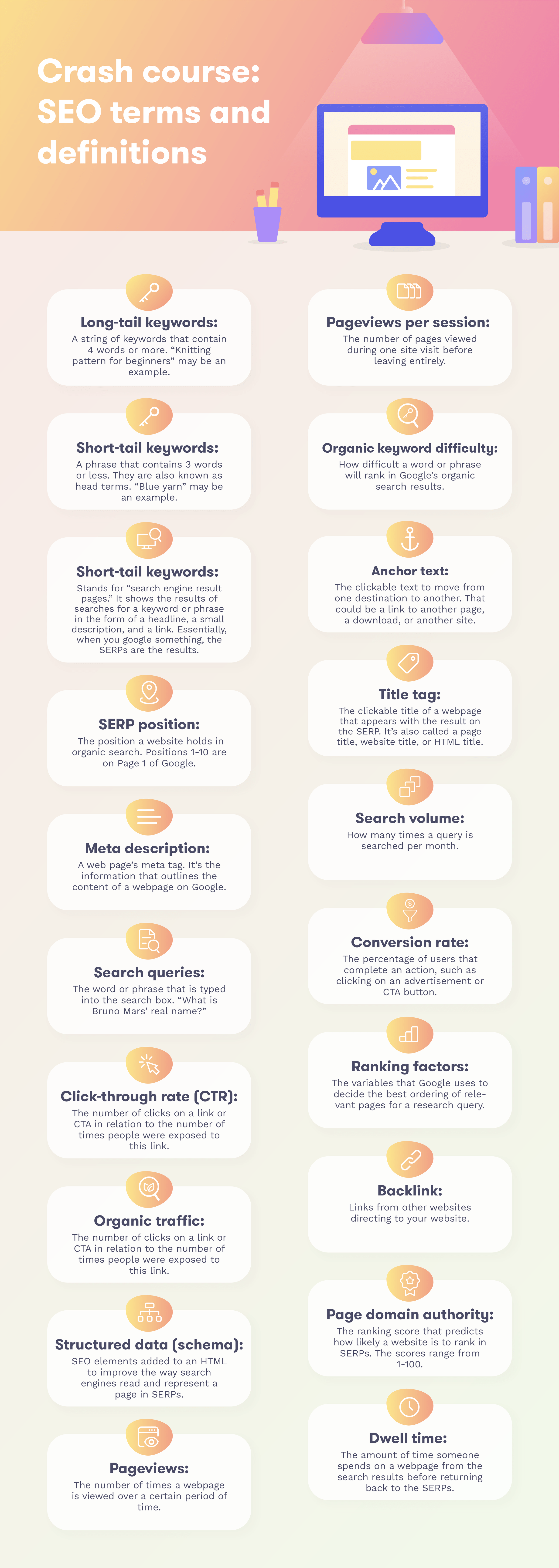Keyword Research Tips to Level Up Your Content Marketing

Keyword research tips + free checklist
Finding the right keywords is crucial to getting your website noticed by search engines. But how do you know which terms will boost your organic traffic? With keyword research, of course!
This blog is designed to help website owners, SEO beginners, and marketers learn to create, analyze, and prioritize keywords. And stick around until the end for three tips that will change your SEO strategy for the better!
Crashcourse: Keyword Research Basics
Before we get into specifics, let’s take a look at some basic SEO research questions, terms, and notions.
What is keyword research?
Keyword research is a method of finding and analyzing the terms that people search for in search engines with the intention to use that data for a specific purpose, such as search engine optimization (SEO) or marketing.
Why does keyword research matter?
Keyword research provides valuable insight into the queries that your target audience is actually searching on Google. This understanding can help guide your content plan and your overall marketing strategy.

How to do keyword research
While there’s no one correct way to conduct keyword research, there are a few steps that will make finding the right words easier.
Now we’ll go into each point in a little more detail.
How to find keyword ideas
You might already have some keywords in mind. Maybe they originate from your content plan, or perhaps they have something to do with your products, services, market-specific topics, etc. That’s a perfect place to start! Make a list of these ideas, also called seed keywords, and later enter them into a keyword research tool like Google Keyword Planner, Moz, or Ahrefs.
Once you have a collection of keywords, you can begin to discover other keywords, questions, and topics that inspire other content creation.
Let’s look at the seed keyword “sourdough bread” as an example:
Some relevant keyword opportunities are:
- Sourdough bread recipe
- Gluten-free sourdough bread
- Is sourdough bread healthy?
By researching our primary keyword in an SEO tool, you’ll easily find more related topics that people are searching on Google.
There are ‘non-traditional’ ways to find keywords as well. Recognizing trending topics and discussions can keep you ahead of the competition. Depending on your niche, you can use social media, Quora, Reddit, AnswerThePublic, and Google Trends as a resource.
Analyzing keyword opportunities
Now that you’ve done the research and curated a list of keywords based on your topic and intended audience, the next step is selecting the right keywords to bring the most value to your content. When writing something new or creating a new landing page, you should have a primary keyword, the term that best describes the topic of your content.
How to find a primary keyword
The three most important elements in determining your primary keyword are search volume, keyword difficulty, and relevance.
Search volume (SV): The number of times a particular keyword is searched per month across all audiences within the latest 12 month period.
Keyword difficulty (KD): The level of competition in relation to sites ranking for the same keyword. The scale is from 0-100, with 100 being the most difficult.
Keep in mind that every SEO tool calculates this number differently. Some base it solely off the mean of the number of linking domains, and others could take into account Page Authority, Domain Authority, and click-through-rates. Since the KD numbers differ between tools, make sure you only use one value, otherwise, your content analytics won’t be accurate!
Relevance: The indication of how related a website is to a particular search term or topic. For instance, if you have a website selling artisan flour, you’ll want your content to be related to your overarching theme of bread making. Google prioritizes high-quality and relevant content!
Here’s the magic formula when choosing your keywords 🪄
The perfect primary keyword = High search volume + Low keyword difficulty + High relevance
You might notice that the search volume of keywords greatly differs. For example, “sourdough bread” has a search volume of 77K whereas “gluten-free sourdough bread” has a search volume of 7.9K. While you should always target terms that your intended audience is searching for, in some instances, it may be more beneficial to target terms with lower search volume because they’re typically less competitive as well. But the primary keyword ‘sweet spot’ would be high volume and low keyword difficulty.
Prioritizing keywords
At this point, you should have a brainstorm list of topics and a primary keyword. But what about secondary and long-tail keywords? How do you prioritize all these different terms?
What are secondary keywords?
Secondary keywords are terms that add a little more detail to your primary keyword. They add context to your page to let Google know that your content is relevant to the searched topic. Typically you have 4-5 secondary keywords that you use at least once throughout your website page. They can take form as either a short- or long-tail keyword.
What are short and long-tail keywords?
Short-tail keywords are phrases that contain 3 words or less. They are also known as head terms. “Rye bread” may be an example.
Long-tail keywords are a string of keywords that contain 4 words or more. “Sourdough baking for beginners” may be an example.
In general, when you’re considering which keywords to prioritize, a couple of core questions should come to mind:
- What is my intended audience searching for?
- How many people are searching for it?
- In what format do they want that information? - blog (listicle, complete guide, short or long-form content), video, podcast, etc.
Once you have the basic questions down, you can dig a little deeper to find the perfect keywords:
- Will my keyword convert?
- Will my intended audience actually value the content surrounding the keyword?
- How does my keyword fit into our marketing strategy?
SEO keywords, defined

- Long-tail keywords: A string of keywords that contain 4 words or more. “Knitting pattern for beginners” may be an example.
- Short-tail keywords: A phrase that contains 3 words or less. They are also known as head terms. “Blue yarn” may be an example.
- SERPs: Stands for “search engine result pages.” It shows the results of searches for a keyword or phrase in the form of a headline, a small description, and a link. Essentially, when you google something, the SERPs are the results.
- SERP position: The position a website holds in organic search. Positions 1-10 are on Page 1 of Google.
- Meta description: A web page’s meta tag. It’s the information that outlines the content of a webpage on Google.
- Search queries: The word or phrase that is typed into the search box. “What is Bruno Mars' real name?”
- Click-through rate (CTR): The number of clicks on a link or CTA in relation to the number of times people were exposed to this link.
- Organic traffic: The number of visitors to your website from unpaid sources.
- Structured data (schema): SEO elements added to an HTML to improve the way search engines read and represent a page in SERPs.
- Pageviews: The number of times a webpage is viewed over a certain period of time.
- Pageviews per session: The number of pages viewed during one site visit before leaving entirely.
- Organic keyword difficulty: How difficult a word or phrase will rank in Google’s organic search results.
- Anchor text: The clickable text to move from one destination to another. That could be a link to another page, a download, or another site.
- Title tag: The clickable title of a webpage that appears with the result on the SERP. It’s also called a page title, website title, or HTML title.
- Search volume: How many times a query is searched per month.
- Conversion rate: The percentage of users that complete an action, such as clicking on an advertisement or CTA button.
- Ranking factors: The variables that Google uses to decide the best ordering of relevant pages for a research query.
- Backlink: Links from other websites directing to your website.
- Page domain authority: The ranking score that predicts how likely a website is to rank in SERPs. The scores range from 1-100.
- Dwell time: The amount of time someone spends on a webpage from the search results before returning back to the SERPs.
Keyword research tips
Since you’re now a keyword research master, we have three tips to help you choose keywords that will optimize your content’s performance for Google.
1️⃣ Understand your audience
First and foremost, finding the right keywords starts with knowing your intended audience. If you understand who is looking for your content, you can better find the keywords that will rank in Google.
Say you have a blog about baking sourdough bread. You’ll want to rank for keywords like “sourdough bread” or “sourdough bread recipes,” but those words, often called fat head keywords, are super competitive because people regularly search for them. If you do a little more research on your audience and niche, you’ll find that people interested in cooking may also be interested in keywords like:
- Sourdough rye recipes
- Artisan sourdough bread recipe
- How to store sourdough bread
- Best sourdough bread
2️⃣ Dissect your competitors’ keywords
One of the best ways to boost your organic SEO is to perform competitor keyword research. Competitor keywords are the terms that competing companies target to achieve search engine rankings. You can use your competitors’ keywords for insight into their audiences’ interests which will help you choose keywords. Knowing your competitors’ keywords also:
- Lets you see what is/isn’t working for them
- Uncovers new or secondary keywords
- Gives you a chance to go into more detail on a given topic or discussion
In most cases, you’ll use an SEO tool to find out what these keywords are. For a quick overview, check your competitors' ranking changes. Typically this report will find your competition’s weak spots and tells you which topics to target.
3️⃣ Find content gaps
A content gap is a topic or subject in your industry that’s not currently covered or addressed with sufficient content. Content that’s fresh or new, or maybe has a new take, can set your website apart from competitors. But how do you find a content gap?
- Run a content gap report on an SEO tool
- Ask your audience directly on social media
- Conduct a brainstorming session with peers, coworkers, or people within your niche
- Peruse your competitor's sites to see where they’re lacking
- Engage in community discussions
- Make your content special, unique, and different
The point of finding a content gap is not to distribute more secondary keywords throughout your content, but rather as a way to find a topic. You can then create content that is high-quality, relevant, and helpful within your niche.
